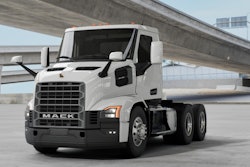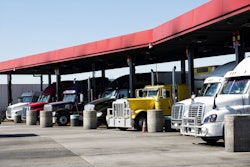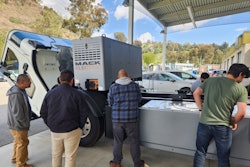Caterpillar Engine Division, Mossville, Ill., knows how it will meet truck diesel emission standards, at least until 2007 and, likely, beyond. And, it will do so without cooled exhaust-gas recirculation (EGR)-an emissions remedy thought to be indispensable in meeting future emissions regs.
Cat’s strategy is called ACERT (for “Advanced Combustion Emissions Reduction Technology”), and the strategy is simple, at least in concept. Cat will combine an enhanced version of its HEUI (hydraulic-electronic unit injection) system, which will minimize emissions in the cylinder, with a simple oxidizing catalytic converter to polish off particulate and hydrocarbons. This type of catalyst does not require the use of low-sulfur fuel (though emissions would be lower with such fuel) and, says Cat, it has already proven effective and reliable on smaller trucks using Caterpillar 3126 engines.
Claimed advantages of the system will include efficient packaging, lower noise, and enhanced engine-brake performance. Fuel economy will be as good as with current engines, and engine ratings will remain the same. Caterpillar’s David Semlow, marketing manager of the truck engine division, says, “ACERT is a customer-driven solution that is designed for the long-term.”
Cat says the elimination of the engine-coolant-cooled EGR system saves a good deal of room in the engine compartment, and minimizes installation complexity and the need for new hardware, while minimizing the increase in heat rejection. Since the total amount of heat the radiator must carry away for a given power rating is likely to be only 2-3% higher than with current engines, present radiators and frontal areas should provide more than adequate cooling.
This should mean a minimal cost impact for the truck builders and end users. According to Cat’s John Campbell, director, performance engine products division, “The simplicity of the system will mean that the transition from current engines to ACERT-equipped engines will be almost unnoticeable to the customer.”
Cat claims the combustion system will produce much lower noise, and company engineers intend to make the most of this by fine-tuning the block design to dampen vibration still further. This, says Cat, will produce a 50% reduction in engine noise level.
On the C15 and C16 engines, the large camshaft and drive gears will be downsized, and replaced by a quieter, smaller drive system and a smaller-diameter camshaft, with only two valve-operating lobes per cylinder. The heavy-duty camshaft and rockers which now drive the mechanical injectors will be replaced by a high-pressure oil pump-driven by the crankshaft-and hydraulically actuated injectors. This pump is separate from the engine lube oil pump, and will produce much higher pressures (likely, approximately 3,000 psi or higher). A gallery will conduct engine oil to the injectors, with pressure regulated by an electronically controlled bypass valve. This rail pressure, and all timing and metering, will be controlled via an enhanced version of Cat’s ADEM 2000 electronic control module, with twice the processing power of the present system. The same hydraulic/electronic system that controls the injectors will control the engine brake, for what Cat says will be a 20% improvement in performance.
The HEUI injectors drive their fuel metering/atomizing plungers downward using high oil pressure, rather than the standard heavy-duty camshaft and rocker arrangement. The enhanced injectors will be able to produce very high injection pressures (Caterpillar would not reveal specific numbers). Cat has chosen this injection system because its ability to produce pressure is always present, even at low rpm or idle, when the standard, mechanically activated system can lose some of its punch. This ability is part of what allows the system to control NOx in the cylinder without high levels of particulate and hydrocarbons. When asked whether or not the HEUI injectors would be combined with an enhanced combustion chamber design, Campbell refused to comment. Much of the discussion centered on minimizing the engine’s emissions right in the cylinder.
The ACERT system will become standard on Caterpillar’s offerings in 2003. In the meantime, the company is negotiating with the EPA to find a way to cover its need to meet the 2002 requirements without it-possibly through the trading of credits.
Cummins chips away at NOx
Cummins Engine Co., Columbus, Ind., has launched a voluntary initiative to lower levels of oxides of nitrogen (NOx) emitted from its diesel engines.
New calibrations are available on 1996-1998 Cummins M11 Plus and N14 Plus engines. Customers can go to Cummins distributors or dealers to have the electronic calibrations uploaded-a process that takes a few minutes.
Meanwhile, Cummins continues its development work on cooled exhaust gas recirculation (EGR). The technology was successfully demonstrated on the next generation of the company’s B Series engine, and is being applied to its other medium and heavy-duty engines.
Cummins claims to have: achieved a 2% improvement in fuel economy compared to its current product; reduced NOx by 50%; and reduced unaided cold starting time by 80%.
In addition, says Cummins, throttle response is significantly improved through the use of variable-geometry turbocharging.
The old water-in-the-fuel trick
Lubrizol Corp., Wickliffe, Ohio, has introduced PuriNOx, an “economical, lower-emission alternative to conventional fuel,” which consists of diesel fuel, 10-20% purified water, and a proprietary Lubrizol additive package.
Use of the fuel, says Lubrizol, has reduced oxides of nitrogen (NOx) by 32% and particulate matter (PM) by 55% in large buses at Laketrans, a transit fleet located near Cleveland. The company describes the technology as “fill and go,” and says the fuel can be used in existing diesel engines without any modifications. No changes to the fueling infrastructure are required, either.
To make the product, water is purified, broken up into extremely small droplets, and then mixed in the correct proportions with the fuel and the chemical additive package. This results in very tiny droplets, each of which is surrounded by a chemical shell, encapsulating the water. The emulsified droplets are then invisible to the fuel system. Lubricity, for example, is said to be identical to that of straight diesel, thus preventing injector wear problems.
The water is claimed to reduce NOx emissions by lowering peak combustion temperatures. It also improves atomization and distribution of fuel in the combustion chamber, as revealed in laboratory studies. It does this by evaporating explosively when exposed to the high heat. It also slightly increases ignition delay. These effects, plus chemical effects, explain the significant reduction in PM.
The resulting mix will sell for approximately the same price as an equivalent volume of diesel fuel. But, because water has no energy content, there is a slight reduction in peak power and in fuel economy.
The fuel has been tested in Caterpillar, Cummins, and Detroit diesel engines and should work in any older equipment. In fact, the technology was a joint development of Lubrizol and Caterpillar.









